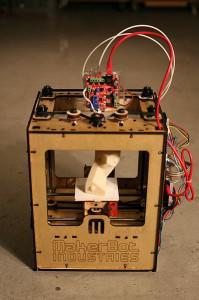 Still far from the replicator technology in Star Trek, reasonably affordable commercial 3D printers like the $2000 MakerBot and $1300 Cube are still for the hobbyist but is quicklymoving away from design laboratories and proof of concept exhibitions and into the consumer market. A 3D printer is what it sounds like it is, instead of using a mold or a cast to create an object, a digital blueprint can be downloaded and loaded into the printer and a machine nozzle sprays down a hot plastic goop layer by layer until the object is complete. The 3D printing process has been in use for about 10 years, but as the process becomes less expensive and more accessible, its massive potential impact on manufacturing has led The Economist to claims of a “Third Industrial Revolution”. Given this attention, it’s worth a brief look at how 3D printing could be an environmental catastrophe or green dream with regards to waste.
Still far from the replicator technology in Star Trek, reasonably affordable commercial 3D printers like the $2000 MakerBot and $1300 Cube are still for the hobbyist but is quicklymoving away from design laboratories and proof of concept exhibitions and into the consumer market. A 3D printer is what it sounds like it is, instead of using a mold or a cast to create an object, a digital blueprint can be downloaded and loaded into the printer and a machine nozzle sprays down a hot plastic goop layer by layer until the object is complete. The 3D printing process has been in use for about 10 years, but as the process becomes less expensive and more accessible, its massive potential impact on manufacturing has led The Economist to claims of a “Third Industrial Revolution”. Given this attention, it’s worth a brief look at how 3D printing could be an environmental catastrophe or green dream with regards to waste.
At the industrial level of 3D printing, most manufacturing is currently subtractive, meaning you have a big block that you whittle down to what you need. This leads to a lot of waste. For example, airline manufacturing takes a big hunk of titanium (expensive) and pokes and drills at it until 90% is whittled away, and can be used for other projects, but is no longer aerospace grade,,. In contrast, 3D printers are additive, meaning the nozzle only puts down the material (let’s call it input goop) that it needs to print the design. Thus more industrial waste is mitigated as more firms turn to 3D printing for precision manufacture. In short, better stuff with less waste. Kudos.
OK, fair enough. The big fork in the road when it comes to the environmental attractiveness of 3D printing is the nature of the input goop. If 3D printers do make it into the commercial mainstream, and the input goop remains unrecyclable plastic, then 3D printing is potentially a high-tech faucet spewing out plastic junk we don’t need in the same way that the commodification of the paper printer led to an explosion in paper waste.
However, if our brilliant engineers can brew up strong, malleable and easily recyclable input goop the environmental story changes significantly. Easily recyclable 3D printer goop would be an environmental boon; instead of throwing away broken, outdated, unfashionable, or inefficient goods as waste we could use them as inputs for the things we do want. Shoes getting old? Print a new pair! Pink out of style? Try Honey Gold. Ok, granted it would take an awful of a lot of energy in both the recycling and printing phase, and I’m not a materials engineer, but we already have plastic recycling and we have bio-plastics so it can’t be completely out of the realm of possibility, can it? Call me optimistic, but I think this Third Industrial Revolution will have a lot in common with the Second Green Revolution.

